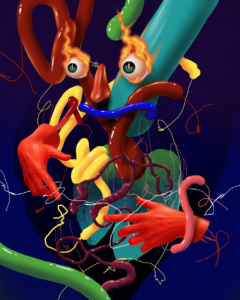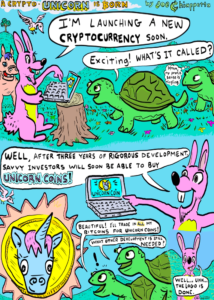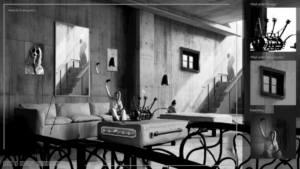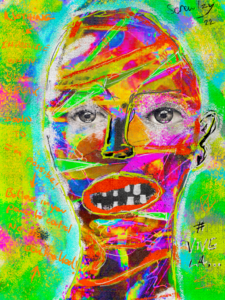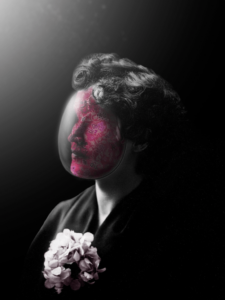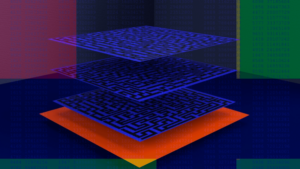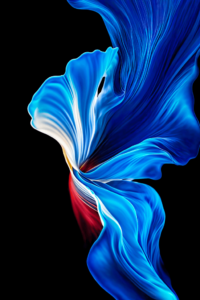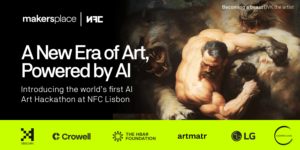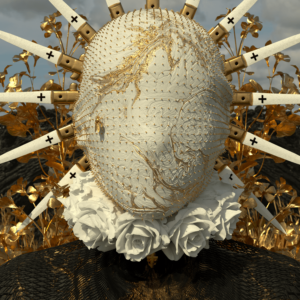“We can all influence the future. That’s why I paint. Forever.”
— Mamadou Sow
From the quaint Senegalese village of Malika near Dakar to the vast expanse of the digital art world, Mamadou Sow’s journey is a testament to his passion and dedication.
At 36 years old, Sow has always had a penchant for vibrant colors and has used art as a means to internally confront trauma, politics, and the nuances of life. However, those seeking merely aesthetically pleasing artwork may not fully grasp the depth and intention behind Sow’s creations.
Regarded by many as a pioneer of the digital art era, Sow masterfully integrates sarcasm and virtual aesthetics to highlight global political issues. His artwork is deeply influenced by his early life experiences in Africa and the challenges he faced.
His experiences as a black man navigating life in Germany and confronting worldwide discrimination are evident in his pieces. Through his artwork, Sow offers a unique lens through which viewers can understand his perspective on the world.
In his artistic journey, Sow undergoes what he terms “flight mode phases.” During these phases, he immerses himself in his work, sometimes for weeks on end, distancing himself from external distractions. Using his iPad, every stroke and color is meticulously crafted by hand, without any automated tools. This dedication means that a single piece might take him up to 150 hours to finalize.
An integral part of his creative process is his ability to lucid dream, which for Sow, often holds more weight and meaning than waking reality. These dreams provide a rich tapestry of inspiration and insight for his artwork.
Aisha Arif: Your journey from a small village in Senegal to Germany, and now to the undefined boundaries of the global digital art scene, is quite remarkable. Could you tell us more about how your early experiences influenced your decision to pursue art as a means of expression?
Mamadou Sow: My early experiences were mainly were due to a language barrier. Arriving from Africa, I couldn’t speak German, but I could paint and draw. So I learned the language by painting or drawing things, and people explained it to me. My first touch of communication was through pictures.
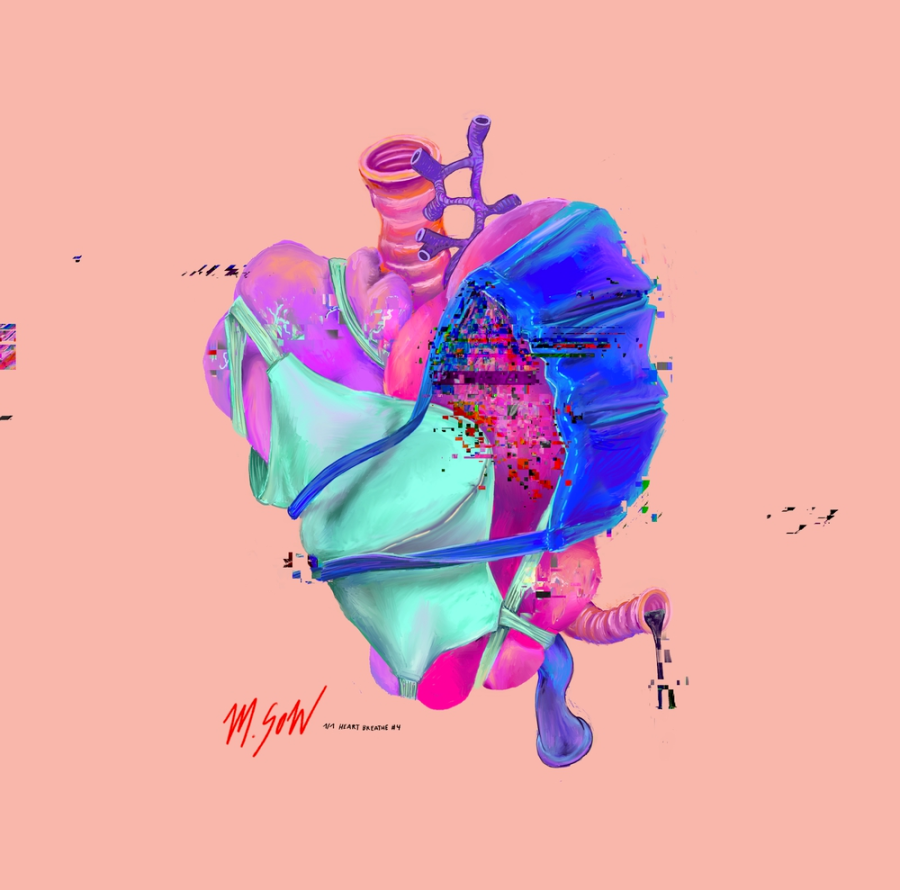
AA: Your art addresses political grievances and global discrimination. Can you share some specific examples of artworks which serve as commentary on these issues and how?
MS: My work tackles pressing issues such as racism and discrimination, with specific pieces like WHITE SUPREMACY, K-L-I-C-K, and Tragic Decadence serving as commentary on these matters. My artworks WHITE SUPREMACY and K-L-I-C-K were made right after the killing of George Floyd. And K-L-I-C-K shows how important it is that we record situations where we see injustice. The piece WHITE SUPREMACY depicts two white vultures attacking a young black boy. It also reflects my own experiences with racism. And these pictures are kind of a wake-up call. And to this time it was a very new way of thinking or expressing myself.

AA: In your artist statement, you mention the use of sarcasm and virtual aesthetics in your work. How do these elements help you convey your messages and themes effectively?
MS: I employ sarcasm and virtual aesthetics to create thought-provoking contrasts in my pieces. I try to use symbols that we recognize and then place them in a different context. Or I take things that are beautiful to the eye but not beautiful in content. Like the breathing heart that I made, it looks like a kind and beautiful picture. But at the same time, it’s a depiction of a real heart covered in breathing masks. Although this isn’t aesthetically pleasant, I turned it into something beautiful.
AA: The Tale of the Black Whale combines elements of luxury, environmental degradation, and cultural commentary. Can you elaborate on the symbolism behind the choice of these elements in your artwork?
MS: I use Lamborghinis because they represent the fast and early success that people experienced in the crypto space. And I used Barbie dolls to show how I grew up in a time where idols were predominantly whitewashed. I never had a hero, someone like Black Panther today, with whom I could identify. These symbols of the past are swimming in the ocean, and while Barbies are sinking, Lamborghinis, which can’t swim in reality, are floating. This juxtaposition illustrates how some cultural elements fade while others persist. Additionally, the piece comments on plastic pollution, which I believe is largely the responsibility of the wealthy. That’s why I depicted the Lamborghini swimming.

AA: Your artwork involves meticulous hand-drawing on an iPad, sometimes taking up to 150 hours to complete. How does this process impact your connection with your art, and what role does the use of technology play in your creative process?
MS: My meticulous process on the iPad underscores my commitment to using technology as a creative tool. I’m passionate about utilizing the latest technology because I’m constantly thinking about it. Whenever Apple releases something new, I feel a compelling need to have the latest and most powerful device, whether it’s a computer or, in this case, a tablet. It’s akin to an artist wanting the best brush; I want the best iPad. I rely on these tools to work with new technologies like AI and innovation.

AA: You mentioned using lucid dreaming as a source of inspiration. Could you share a specific instance where a dream influenced one of your artworks, and how did that dream translate into your artistic vision?
MS: Lucid dreams heavily influence and shape my artwork. These dreams manifest in various elements of my pieces, such as the floating Lamborghinis. After waking from a dream, I often feel inspired to create. In my dreams, I might visit a cinema and watch films or attend exhibitions and view art. The images I see deeply impress me. I’ve realized that much of what I create originates from my dreams and memories. Every piece I produce reflects these visions. For instance, the floating Lamborghinis in the sea were inspired by an exhibition I dreamt about.
AA: Your artwork blends diverse cultural backgrounds and societal perspectives. How do you believe your unique dual heritage informs your artistic perspective and influences the themes you explore?
MS: My dual heritage and exposure to diverse cultures shape my artistic perspective, pushing me to challenge conventions and trust my creative intuition. From a young age, I understood that societal rules differed across cultures. For example, in Germany, I was told as a child not to eat with my hands, but in Africa, everyone does. I learned early that to fit into society, I sometimes had to break these rules. Now, as an artist, I choose to defy trends and instead follow my own path when creating art.
AA: In your bio, you mention flight mode phases where you isolate yourself to create art. Could you describe the significance of these phases and how they contribute to your creative process?
MS: The flight mode phases serve as a coping mechanism, allowing me to channel my emotions into art, even though it might be challenging for my mental well-being. When I’m in a flight mode phase, it often means I’m experiencing sadness or depression. These emotions seep into my artwork. While some of my pieces might appear cheerful due to their colors and aesthetics, the time and effort I invest often correlate with my emotional state. This is my way of processing feelings, and I appreciate any support or conversation from the community on this topic. Please don’t hesitate to reach out.
AA: In your own words, why do you believe art is a powerful medium for influencing the future and effecting change? How do you hope your art will contribute to shaping the world’s future?
MS: I firmly believe that art has the potential to foster peace and understanding on a global scale. I aim to dismantle cultural barriers, like the distinction between German and African, in art, focusing instead on the difference between meaningful art and superficial art. I hope to spark discussions and believe that art can serve as a universal language. As it did for me in my youth, I hope art can be a vehicle to promote peace worldwide. My personal journey and the stories I tell through my art underscore the transformative and unifying potential of art in our society.
For updates on all of our upcoming artist interviews, subscribe to our newsletter below.
- SEO Powered Content & PR Distribution. Get Amplified Today.
- PlatoData.Network Vertical Generative Ai. Empower Yourself. Access Here.
- PlatoAiStream. Web3 Intelligence. Knowledge Amplified. Access Here.
- PlatoESG. Carbon, CleanTech, Energy, Environment, Solar, Waste Management. Access Here.
- PlatoHealth. Biotech and Clinical Trials Intelligence. Access Here.
- Source: https://rare.makersplace.com/2023/10/05/flight-modes-sarcasm-and-virtual-aesthetics-interview-with-mamadou-sow/?utm_source=rss&utm_medium=rss&utm_campaign=flight-modes-sarcasm-and-virtual-aesthetics-interview-with-mamadou-sow
- :has
- :is
- :not
- :where
- $UP
- 1
- 150
- 36
- 9
- a
- ability
- About
- about IT
- across
- Additionally
- addresses
- africa
- African
- After
- age
- AI
- aim
- All
- Allowing
- also
- Although
- always
- American
- an
- and
- any
- appear
- Apple
- appreciate
- ARE
- arriving
- Art
- artist
- artistic
- artwork
- artworks
- AS
- At
- Attacking
- attend
- Automated
- backgrounds
- barrier
- barriers
- BE
- beautiful
- because
- behind
- believe
- below
- BEST
- between
- Black
- blends
- blockchain
- boundaries
- Break
- BREATHE
- breathing
- but
- by
- call
- CAN
- case
- challenge
- challenges
- challenging
- change
- Channel
- child
- choice
- Choose
- Cinema
- color
- combines
- Commentary
- comments
- commitment
- Communication
- community
- compelling
- complete
- computer
- connection
- constantly
- content
- context
- contrasts
- contribute
- Conventions
- Conversation
- could
- covered
- crafted
- create
- Creating
- creations
- Creative
- crypto
- crypto space
- cultural
- decision
- dedication
- depression
- depth
- describe
- device
- DID
- difference
- different
- digital
- Digital Art
- Discrimination
- discussions
- distinction
- diverse
- do
- does
- Dont
- draw
- drawing
- dream
- dreams
- dreamt
- due
- during
- Early
- eat
- Editorial
- Effecting
- effectively
- effort
- Elaborate
- elements
- emotions
- end
- environmental
- Era
- Even
- Every
- everyone
- evident
- example
- examples
- exhibition
- Exhibitions
- experienced
- Experiences
- experiencing
- explained
- explore
- Exposure
- expression
- external
- eye
- faced
- fade
- FAST
- feel
- feelings
- films
- finalize
- firmly
- First
- fit
- flight
- floating
- Floyd
- focusing
- follow
- For
- forever
- Foster
- from
- fully
- future
- George
- German
- Germany
- Global
- global digital
- global scale
- grasp
- grew
- had
- hand
- Hands
- Have
- he
- Heart
- heavily
- help
- heritage
- Hero
- Highlight
- him
- his
- holds
- hope
- HOURS
- How
- However
- HTTPS
- i
- identify
- iii
- illustrates
- image
- images
- Impact
- important
- in
- influence
- influenced
- influencing
- informs
- injustice
- Innovation
- insight
- Inspiration
- inspired
- instance
- instead
- integral
- Integrates
- Intention
- internally
- Interview
- Interviews
- into
- intuition
- Invest
- involves
- iPad
- issues
- IT
- journey
- Kind
- Lamborghini
- lamborghinis
- language
- largely
- latest
- learned
- Lens
- Life
- like
- LOOKS
- lucid
- Luxury
- made
- mailchimp
- mainly
- man
- many
- Masks
- Matters
- max-width
- May..
- me
- meaning
- meaningful
- means
- mechanism
- medium
- Memories
- mental
- mention
- mentioned
- merely
- messages
- meticulous
- meticulously
- might
- miss
- Mode
- modes
- more
- most
- much
- my
- myself
- navigating
- Near
- Need
- never
- New
- New technologies
- Newsletter
- now
- nuances
- ocean
- of
- Offers
- often
- Old
- on
- ONE
- or
- Others
- our
- out
- own
- paint
- painting
- part
- passion
- passionate
- past
- path
- peace
- People
- personal
- perspective
- perspectives
- phase
- picture
- Pictures
- piece
- pieces
- pioneer
- Place
- plastic
- plato
- Plato AiStream
- Plato Data Intelligence
- PlatoAiCast
- PlatoData
- Play
- please
- plugin
- political
- politics
- Pollution
- potential
- powerful
- predominantly
- pressing
- process
- processing
- produce
- promote
- provide
- pursue
- Pushing
- quite
- racism
- reach
- real
- Reality
- realized
- recognize
- record
- reflects
- Releases
- rely
- remarkable
- represent
- responsibility
- Rich
- right
- Role
- rules
- same
- Sarcasm
- Scale
- scene
- SEA
- see
- seeking
- serve
- serving
- Shape
- shaping
- Share
- show
- Shows
- significance
- single
- situations
- small
- So
- societal
- Society
- some
- Someone
- something
- sometimes
- Source
- sow
- Space
- Spark
- speak
- specific
- State
- Statement
- Stories
- subscribe
- success
- such
- support
- swimming
- Tablet
- Tackles
- Take
- taking
- tale
- Technologies
- Technology
- tell
- terms
- testament
- than
- that
- The
- The Future
- the world
- their
- Them
- themes
- then
- These
- they
- things
- Thinking
- this
- those
- though?
- thought-provoking
- Through
- time
- to
- today
- told
- tool
- tools
- topic
- touch
- transformative
- translate
- Trends
- Trust
- try
- Turned
- two
- undergoes
- underscore
- underscores
- understand
- understanding
- understood
- unique
- Universal
- upcoming
- Updates
- us
- use
- used
- using
- Utilizing
- various
- Vast
- vehicle
- very
- vibrant
- View
- viewers
- Village
- Virtual
- vision
- visions
- Visit
- want
- wanting
- was
- Watch
- Way..
- we
- wealthy
- Web3
- Weeks
- weight
- were
- Whale
- What
- when
- whenever
- whether
- which
- while
- white
- whom
- why
- will
- with
- without
- WordPress
- WordPress plugin
- words
- Work
- world
- world’s
- worldwide
- years
- you
- young
- Your
- yourself
- youth

